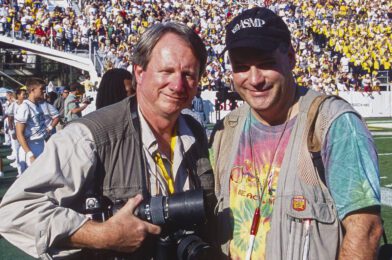My good friend Ken Touchton and I are covering a Georgia Tech football game. Ken has been one of my best business mentors.
Both Ken and I worked with the photo agency Black Star.
Black Star, also known as Black Star Publishing Company, was started by refugees from Germany who had established photographic agencies there in the 1920s. Today it is a New York City-based photographic agency with offices in London and White Plains, New York. It was the first privately owned picture agency in the United States and introduced numerous new techniques in photography and illustrated journalism. Life magazine’s editor Henry Luce relied on them for coverage.
Black Star was formed in December 1935. The three founders were Kurt Safranski, Ernest Mayer, and Kurt Kornfeld. In 1964, the company was sold to Howard Chapnick.
He taught annual workshops at the University of Missouri School of Journalism. In 1994 he published a book called Truth Needs No Ally: Inside Photojournalism, summarizing his many years of experience in dealing with photojournalists and sharing it with those who want to be one.
Howard Chapnick was a principal founder of the W. Eugene Smith competition and Memorial Fund, which awards grants for projects in humanistic photography. After he died in 1996, this Fund established in his memory a gift to encourage and support leadership in fields ancillary to photojournalism.
I was talking with Ken the other day, and he let me know how he first started to work with Howard Chapnick.
Now the way it worked in those 1970s – 1990s, the agencies signed on photographers, and if you signed on first in New York City, then if the job called for your skills, you were the first they contacted.
Well, when Ken was talking to Howard about working for them, Howard pointed out where he lived or mentioned moving to they already had photographers.
Ken said to Howard, “Well, Howard, I need you to handle my administrative side for me. I will find the clients, bring them to you, and ask you to help negotiate rates and collect my payment.”
HUGE TIP!!!!!
If you are starting and don’t know the business side of this industry, then what Ken Touchton did in the 1970s was a brilliant move. While taking this approach, Ken gave up a sizable chunk of money for the clients he found. Agencies often take 20% – 50% of the billings, which can be substantial.
Ken knew and admitted up front to himself that Black Star, specifically Howard Chapnick, could do a better job of knowing a reasonable rate for the work he was doing and negotiate a better deal than Ken could do by himself.
Put yourself into Howard Chapnick’s shoes. Which photographer do you want to represent? Do you want to describe someone you have to go and find a business for or the photographer bringing you a business?
It didn’t take long before Ken wasn’t just bringing business to Black Star but now getting business from them.
Now there are so many things I learned from Ken about business and my time working with Howard Chapnick, but I want to be sure and point out what Ken and I discovered through the years.
We learned to listen to those photographers whose business success was extraordinary. Sometimes their photography was mediocre, but we did notice they understood how to put food on the table. One of those was Howard Chapnick. He didn’t take photos for a living but helped administer some of the most outstanding photographers ever careers.
Black Star photographers include Robert Capa, Andreas Feininger, Germaine Krull, Philippe Halsman, W. Eugene Smith, Bill Brandt, Henri Cartier-Bresson, Charles Moore, Lee Lockwood, and my mentors Don Rutledge and Ken Touchton.
Summary: If you are not good with the industry’s business side, partner with someone who is, and you will do much better than going it alone.


